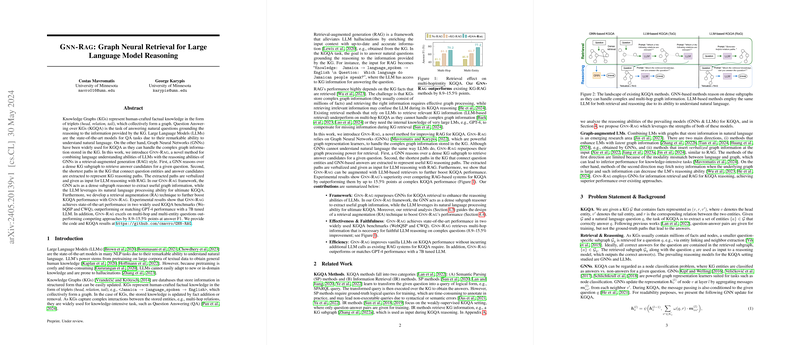Combining LLMs and Graph Neural Networks for Improved Knowledge Graph Question Answering
The paper presented explores a novel method titled "Gnn-Rag," which synergistically integrates LLMs with Graph Neural Networks (GNNs) to enhance the performance of Knowledge Graph Question Answering (KGQA). This approach bridges the strengths of LLMs in understanding natural language and the capabilities of GNNs in processing complex graph structures. The underlying challenge of KGQA is to accurately answer natural language questions using the structured information stored in Knowledge Graphs (KGs).
Core Contributions
- Framework Design: Gnn-Rag is designed to leverage the dense subgraph reasoning capabilities of GNNs for initial retrieval of candidate answers. These candidates are then verbalized and fed into LLMs for final answer generation. This multi-stage process capitalizes on the unique advantages of GNNs in graph traversal and LLMs in language understanding.
- Retrieval Augmentation (RA): The authors introduce a retrieval augmentation technique that further refines the retrieval process by combining outputs from GNN-based retrievers and LLM-based retrievers, thereby enhancing the diversity and accuracy of the retrieved information.
- Comprehensive Evaluation: Using two widely recognized KGQA benchmarks—WebQSP and CWQ—the paper demonstrates that Gnn-Rag outperforms existing state-of-the-art methods. Remarkably, Gnn-Rag with retrieval augmentation achieves up to 15.5 percentage points improvement in complex question answering tasks.
Experimental Results
The empirical results underscore several key findings:
- Multi-Hop and Multi-Entity Questions: Gnn-Rag particularly excels in handling multi-hop and multi-entity questions, surpassing competing approaches by substantial margins (8.9–15.5 percentage points in answer F1).
- Efficiency: Gnn-Rag achieves these improvements without the need for extensive computational resources commonly associated with larger LMs like GPT-4. For instance, Gnn-Rag matches or outperforms GPT-4 using a tuned LLaMA2-Chat-7B model.
- Faithfulness in Answering: Case studies provided in the paper illustrate how Gnn-Rag improves the faithfulness of LLMs by ensuring that the reasoning paths used for answering are well-grounded in the KG.
Implications and Future Work
The implications of this research are multifaceted, both practically and theoretically:
- Practical Applications: The Gnn-Rag framework can be highly beneficial in applications requiring accurate and up-to-date information retrieval from expansive databases, such as search engines and virtual assistants. By integrating GNNs and LLMs, the method achieves a balance of computational efficiency and high accuracy.
- Theoretical Insights: The method brings forth valuable insights into hybrid models that combine graph-based and language-based learning. It paves the way for future research to further refine such hybrid approaches and explore their applications in other domains.
Looking forward, the research opens several avenues:
- Scalability to Larger KGs: Future work could explore the scalability of Gnn-Rag to even larger KGs, perhaps integrating distributed GNN techniques or exploring more sophisticated retrieval augmentation methods.
- Adaptation to Other Tasks: The principles of combining GNNs with LLMs can be adapted and extended to other graph-based tasks, such as recommendation systems or bioinformatics.
- Enhanced Retrieval Techniques: Further refinement of the retrieval augmentation process could involve advanced ensemble methods or the integration of additional context-aware components.
Conclusion
Gnn-Rag represents a significant step forward in the field of KGQA by effectively combining the reasoning strengths of GNNs with the language comprehension capabilities of LLMs. This innovative method demonstrates superior performance on complex QA tasks while maintaining efficiency, potentially setting a new standard for future research in hybrid AI models.
